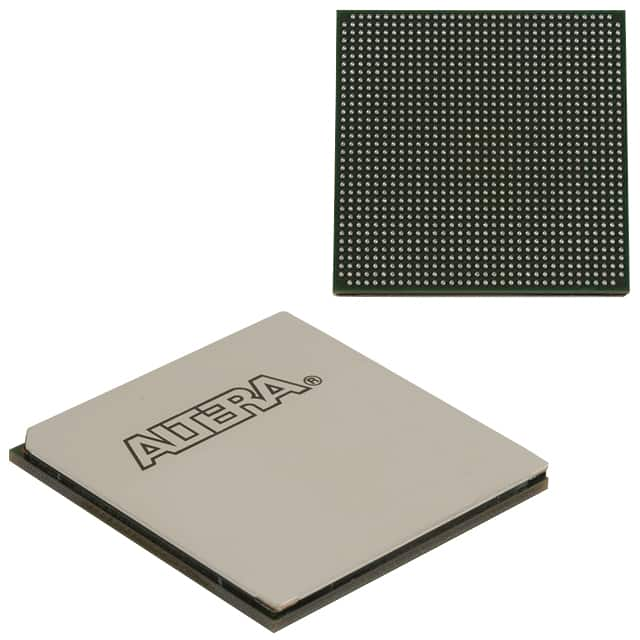Viz Specifikace pro podrobnosti o produktu.

5SGXEA3H3F35I4N
Product Overview
Category
The 5SGXEA3H3F35I4N belongs to the category of Field Programmable Gate Arrays (FPGAs).
Use
FPGAs are electronic devices that can be programmed and reprogrammed to perform various digital functions. The 5SGXEA3H3F35I4N is specifically designed for high-performance applications.
Characteristics
- High-performance FPGA with advanced features
- Offers a large number of logic elements and memory blocks
- Provides high-speed interfaces for data transfer
- Supports complex digital designs and algorithms
- Can be customized and reprogrammed as per application requirements
Package
The 5SGXEA3H3F35I4N comes in a compact package suitable for integration onto printed circuit boards (PCBs).
Essence
The essence of the 5SGXEA3H3F35I4N lies in its ability to provide flexible and customizable digital processing capabilities for high-performance applications.
Packaging/Quantity
The 5SGXEA3H3F35I4N is typically packaged individually and is available in varying quantities depending on customer requirements.
Specifications
- Logic Elements: 220,000
- Memory Blocks: 9,840
- Embedded Multipliers: 1,288
- Maximum User I/Os: 622
- Operating Voltage: 1.2V
- Maximum Operating Frequency: 500 MHz
- Package Type: F35 (35mm x 35mm)
Detailed Pin Configuration
The detailed pin configuration of the 5SGXEA3H3F35I4N can be found in the product datasheet provided by the manufacturer.
Functional Features
- High-performance digital processing capabilities
- Support for complex algorithms and designs
- Flexible and customizable through programming
- High-speed interfaces for efficient data transfer
- Integration with other electronic components
Advantages
- Versatile and adaptable to various applications
- High-performance processing capabilities
- Customizable to meet specific requirements
- Efficient utilization of resources
- Availability of advanced features and interfaces
Disadvantages
- Steep learning curve for programming and utilization
- Higher cost compared to other alternatives
- Limited availability of technical support for complex designs
- Requires expertise in FPGA design and implementation
Working Principles
The 5SGXEA3H3F35I4N operates based on the principles of digital logic. It consists of a large number of configurable logic elements, memory blocks, and specialized circuits that can be interconnected and programmed to perform desired functions. The device is configured using Hardware Description Languages (HDLs) such as VHDL or Verilog.
Detailed Application Field Plans
The 5SGXEA3H3F35I4N finds applications in various fields, including: 1. Telecommunications: High-speed data processing, signal processing, and network infrastructure. 2. Aerospace and Defense: Radar systems, image processing, encryption, and secure communications. 3. Industrial Automation: Control systems, robotics, machine vision, and real-time monitoring. 4. Medical Devices: Imaging systems, diagnostic equipment, and patient monitoring. 5. Automotive: Advanced driver-assistance systems (ADAS), infotainment, and engine control.
Alternative Models
- 5SGXEA3H2F35I4N: Similar to 5SGXEA3H3F35I4N but with a lower number of logic elements.
- 5SGXEA3H4F35I4N: Similar to 5SGXEA3H3F35I4N but with a higher number of logic elements.
- 5SGXEA3H3F40I4N: Similar to 5SGXEA3H3F35I4N but with a higher operating frequency.
These alternative models provide varying capabilities and can be chosen based on specific application requirements.
Note: The content provided above is for illustrative purposes only and may not reflect the actual specifications and features of the product.
Seznam 10 běžných otázek a odpovědí souvisejících s aplikací 5SGXEA3H3F35I4N v technických řešeních
Sure! Here are 10 common questions and answers related to the application of 5SGXEA3H3F35I4N in technical solutions:
Q: What is the 5SGXEA3H3F35I4N FPGA used for? A: The 5SGXEA3H3F35I4N is a Field-Programmable Gate Array (FPGA) that can be used for various applications such as high-performance computing, networking, and signal processing.
Q: What are the key features of the 5SGXEA3H3F35I4N FPGA? A: Some key features of this FPGA include high logic density, high-speed transceivers, embedded memory blocks, and support for various I/O standards.
Q: Can the 5SGXEA3H3F35I4N FPGA be reprogrammed? A: Yes, FPGAs are designed to be reprogrammable, allowing users to modify the functionality of the device even after it has been deployed.
Q: How can the 5SGXEA3H3F35I4N FPGA be programmed? A: The 5SGXEA3H3F35I4N FPGA can be programmed using hardware description languages (HDLs) such as VHDL or Verilog, or through graphical programming tools provided by the FPGA manufacturer.
Q: What are some typical applications of the 5SGXEA3H3F35I4N FPGA? A: This FPGA can be used in applications such as high-frequency trading, video processing, wireless communication systems, radar systems, and data center acceleration.
Q: Does the 5SGXEA3H3F35I4N FPGA support high-speed serial communication? A: Yes, this FPGA has built-in high-speed transceivers that support protocols like PCIe, Ethernet, and Serial RapidIO.
Q: Can the 5SGXEA3H3F35I4N FPGA interface with external memory devices? A: Yes, this FPGA has embedded memory blocks and supports various memory interfaces such as DDR3, DDR4, and QDR IV.
Q: What is the power consumption of the 5SGXEA3H3F35I4N FPGA? A: The power consumption of an FPGA depends on the design and utilization. The datasheet for the specific FPGA model should provide detailed power consumption information.
Q: Are there any development kits available for the 5SGXEA3H3F35I4N FPGA? A: Yes, the FPGA manufacturer typically provides development kits that include the necessary hardware and software tools to get started with designing and programming the FPGA.
Q: Can the 5SGXEA3H3F35I4N FPGA be used in safety-critical applications? A: FPGAs can be used in safety-critical applications, but additional measures need to be taken to ensure functional safety, such as using redundant designs and implementing appropriate fault detection mechanisms.
Please note that the answers provided here are general and may vary depending on the specific requirements and use cases.

